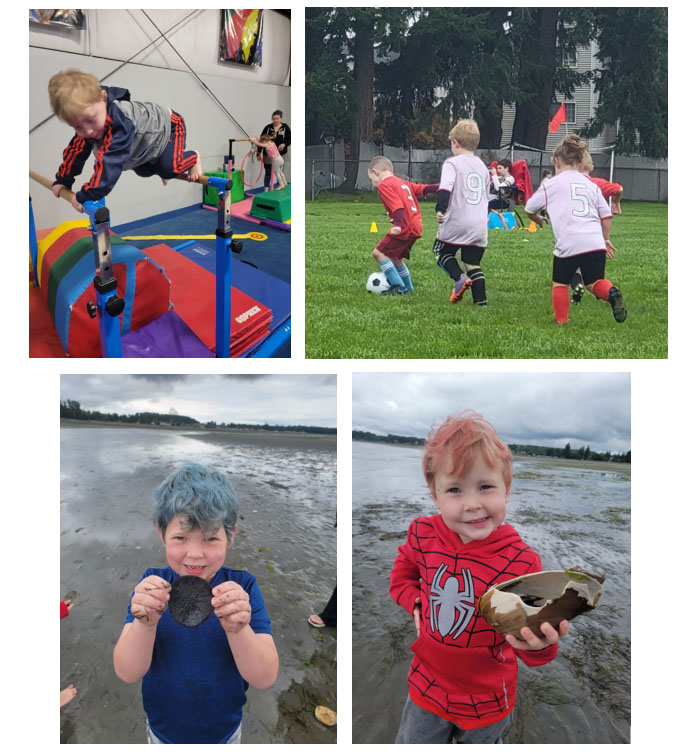Brothers Born with Identical Craniofacial Condition Three Years Apart Thriving After Major Skull Surgeries at Seattle Children’s: ‘I Felt We Were in the Best Hands’
9.5.2023 | Ashley Speller

Each year, Seattle Children’s Craniofacial Center treats hundreds of children with craniosynostosis, a condition most families have never heard of, yet can affect approximately 1 in every 2,500 babies in the United States.
That was the case for Kali Dempsey’s family, of Camano Island, WA, in early 2017.
“We were sent to Seattle Children’s when my son Ronan was about a month old and they diagnosed him there,” explained Dempsey. “It was all brand new. You hear about all kinds of things, but I had never come across craniosynostosis before.”
At birth, the seams between the bone plates in a baby’s skull are not fused together, allowing a child’s head to move through the birth canal and permitting the skull to grow bigger over time. Craniosynostosis is when one or more of these seams closes too early.
There are different types of craniosynostosis including sagittal, coronal, metopic and lambdoid synostosis, and the main treatment is surgery which helps relieve pressure on the brain and allows a child’s skull to grow properly.
“After we make the diagnosis of craniosynostosis, we will get a CT scan and look at a 3D model of the child’s skull to confirm the diagnosis and for our surgeons to make plans about their surgical approach,” explained Dr. Michael Cunningham, division chief of Craniofacial Medicine and medical director of the Seattle Children’s Craniofacial Center. “Depending on which suture is fused, the child will be operated on anytime between about 3-12 months age.”

Dempsey was told Ronan had sagittal synostosis and there were two options offered at Seattle Children’s — open cranial vault remodeling (CVR) or an endoscopic strip craniectomy.
“We have a very large craniofacial team that cares for children with all forms of craniosynostosis,” explained Dr. Richard Hopper, division chief of Craniofacial and Plastic Surgery and surgical director of the Seattle Children’s Craniofacial Center. “We like to empower the family, once they have all of the information, to make the choice that’s best for their baby.”
“It took us about 2-3 weeks to make that decision, and we ended up going with the CVR,” said Dempsey.
Each surgery involves an experienced craniofacial plastic surgeon and a neurosurgeon working as a team in the operating room. Dr. Craig Birgfeld, the director of Plastic Surgery education at Seattle Children’s, and Dr. Amy Lee, the division chief of Neurosurgery at Seattle Children’s, performed the procedure.

“Ronan’s recovery was way faster than we expected, and he was only in the hospital for 3-4 days,” recalled Dempsey.
Three years later, after the birth of her second child, Finnley, Dempsey was shocked to learn that he also had the same condition as his brother.
“It’s an awful situation to be stuck in. Twice. A quote that got us through this was: ‘Tough times never last but tough people do,’ and you just power through it all and do the best you can,” she recalled. “I felt we were in the best hands.”
After discussing the treatment options with her providers and family, they ultimately opted for the CVR surgery.

“We had such an excellent experience the first time around that we knew we wanted to do that again. We also had great results and so it was an easy choice for us,” she explained. “Dr. Birgfeld and Dr. Lee were so great and performed the surgery on Finnley, just like they had done on his older brother. Finnley ended up spending just two nights in the hospital.”
Finnley’s and Ronan’s sagittal synostosis CVR surgeries were exactly 3 years and 3 days apart. Today, they are 4 and 7 years old and will celebrate their ‘cranioversaries’ in January 2024.
Ronan loves soccer and math, and Finnley loves gymnastics and art.
“Our surgeons let us know that their skulls are perfect and rock-solid,” Dempsey said. “They live such normal lives, and you would never be able to tell they had these major surgeries.”
“Every time we go to Seattle Children’s, everybody is so nice and helpful,” Dempsey shared. “It makes it so much easier to hand off your kids when you know that the doctors on the other end are going to be there and treat them like they are one of their own.”
Dempsey hopes her family’s story will help spread community awareness about lesser known craniofacial conditions, educate others on what to look out for, encourage parents who may be going through something similar, and inspire kids to wear their scars like a badge of honor.

“The challenges don’t last forever, take things one day at a time and lean on your support system,” she added.
She is grateful to the doctors and staff in Seattle Children’s Craniofacial Center who showed her family immense care and kindness.
“You just feel like your child is the only one on their docket; like they are the only one that matters. It’s just so reassuring.”
Seattle Children’s Craniofacial Center team has more combined experience treating craniosynostosis than any other center in the country. Leaders from Seattle Children’s Craniofacial Center team will be convening at the 20th Congress of the International Society of Craniofacial Surgery (ISCFS) on Sept. 5-8 to collaborate with providers from across the globe to continue their important work planning for the future of craniofacial surgery.